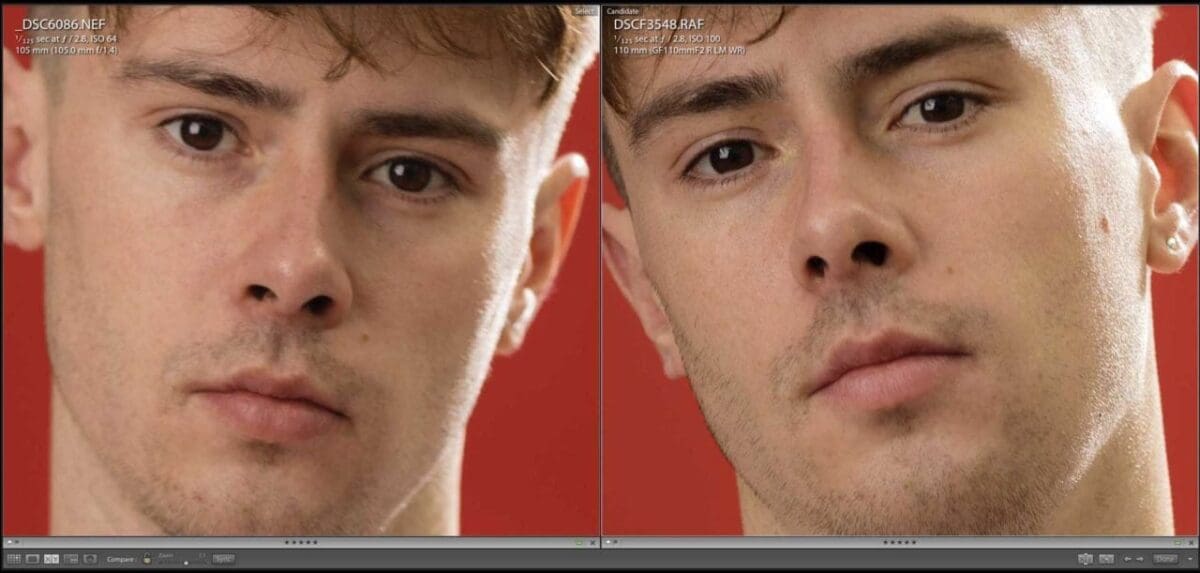The Nikon D850 promises two amazing cameras in one; a speed beast with up to 9fps continuous shooting and the 153-point autofocus system from the flagship D5, together with a super high-resolution 45.7Mp full frame sensor. It sounds too good to be true.
Intrigued to see if the D850’s image quality would hold up against some of the best pound-for-pound image quality you can get, I teamed up with photographer Andy Saywell and headed off to shoot some landscapes and portraits with it and the 51.4Mp medium format Fujifilm GFX 50S.

Snap Verdict
The Nikon D850 is an incredible camera, offering the autofocus and frame rate performance of a high-end DSLR, combined with a massive 45.7Mp resolution for super high-quality images.
In our extensive testing, shooting landscapes and portraits in a wide range of environments and different lighting conditions, the Nikon D850’s image quality isn’t quite as good as the Fujifilm GFX 50S, but it’s not far off.
The most telling difference is sharpness and low light image quality.
When the GFX nails focus, it’s outrageously sharp and its low light jpegs at high ISO are cleaner in the shadows while its raw files can be pulled about more without a significant impact on noise.
The D850 remains amazingly good and at roughly half the cost of the GFX, compatible with the vast range of Nikon and third party lenses and accessories and the performance credentials to effortlessly shoot virtual any subject it’s a mouth-watering prospect.
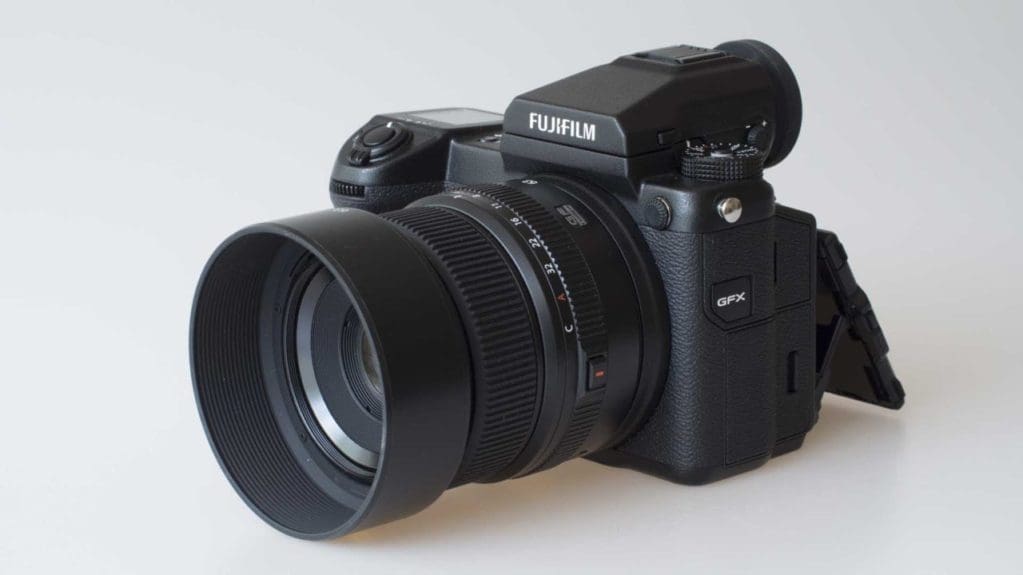
Kit Used
Nikon D850 with Nikkor 14-24 f/2.8G & 105mm f/1.4E and Sigma 35mm f/1.4 A
Fujifilm GFX 50S with GF 23mm f/4, GF 32-64mm f/4, GF 45mm f/2.8 & GF 110mm f/2
Early morning landscape
The GFX’s ‘cropped’ 43.8×32.9mm sensor offers 68% more surface area compared to the D850’s 35.9×23.9mm full frame chip. Being physically bigger, but with a similar resolution, means the GFX offers greater ‘pixel pitch’ of 5.3µm, compared to 4.3µm on the Nikon D850. That, in theory, improves the light gathering potential of the GFX sensor and a cleaner signal should translate into better dynamic range.
To test this, we shot some early morning landscapes, exposing to retain detail in the bright sky and seeing how much shadow detail we could pull back in raw processing.
Nikon D850

Nikon D850 with 14-24mm f/2.8G lens. Exposure ISO 100, f/22, 1 second. Raw adjustments in Lightroom CC Exposure +3, Highlights -100, Shadows +35, Whites +75, with a Graduated Filter to darken the sky. Lens Profile enabled and a Medium Contrast Tone Curve applied.
Fujifilm GFX 50S

Fujifilm GFX 50S with GF23mm f/4 lens. Exposure ISO 100, f/32, 2.3 seconds. Raw adjustments in Lightroom CC Exposure +3, Highlights -100, Shadows +35, Whites +100, with a Graduated Filter to darken the sky. Fujifilm built-in lens profile and a Medium Contrast Tone Curve applied.
Pulling out detail in the raw file with +3 exposure and +35 shadows via Lightroom CC there’s not a significant amount of difference in the shadow areas in front of the rock. Viewing images 1:1 on screen, both control noise really well. Sure, there’s some deterioration on both, but considering how hard the files have been pushed it’s very acceptable and I don’t think you can really say one’s better than the other.
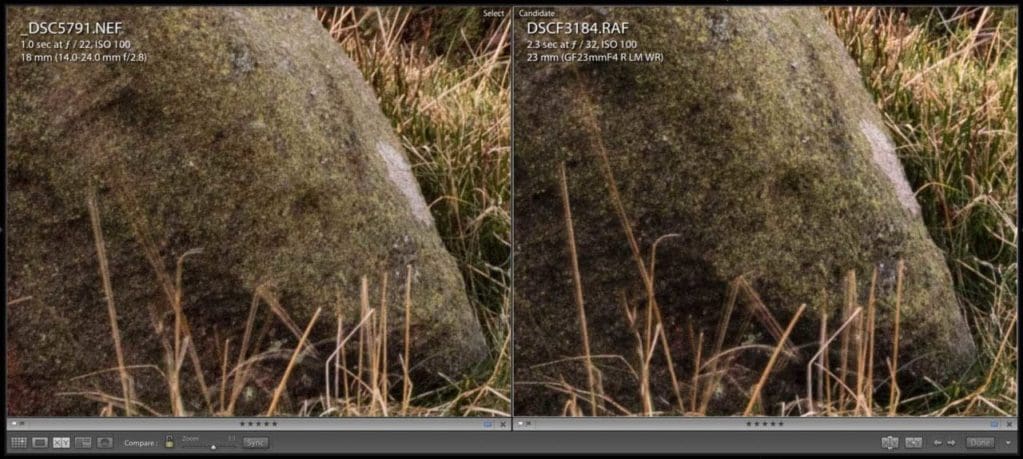
1:1 crops on-screen show the noise on the D850 (left) and GFX (right) are broadly similar with no visible chromatic noise in the shadows despite the aggressive raw processing.
Focusing on the foreground and shooting at the lens’s respective minimum apertures, f/22 for the Nikkor 14-24mm and f/32 for the GF 23mm, extends the depth-of-field as much as possible. The D850’s physically smaller sensor will inherently record greater depth-of-field, but closing down the Fujifilm lens that extra stop to f/32 offsets that. So sharpness on the horizon is again broadly the same on both cameras.

1:1 crops on screen DOF is broadly the same. Shooting both lenses at the minimum aperture, with reasonably well-defined trees on the horizon, but contrast and colour in the middle ground is better on the GFX (right).
Shooting at minimum aperture, diffraction reduces the overall resolution of both lenses. It’s fair to say neither are amazingly sharp in the background, but with trees on the far horizon still clearly defined, together with reasonable sharpness on the foreground, both are capable of great depth-of-field.
Examining crops of the background, you can see the GFX has delivered slightly improved contrast and colour, resulting in better definition in the valley. Both images had the sky pulled back using a -1.5 EV reduction in Exposure and -50 Highlights Graduated Filter and both skies look amazing. The blues maybe slightly richer from the D850 and the oranges more vibrant on the GFX, but small tweaks to the colour channels with the HSL controls you could get similar results on both.
Once the sun had peaked over the horizon, we turned around to shoot with the light behind. Opening up the aperture a stop to reduce diffraction and shooting with the sun behind for a less challenging exposure to maximise the image quality potential of the sensors.
The golden sunlight is a little richer and more vibrant on the GFX shot, with the D850 needing a +10 boost to saturation and vibrance to achieve a similar result. Viewing crops on screen the GFX is a little sharper, thanks again to a little more contrast and definition pulling out details, but to be fair there’s really not much in it. Raw adjustments were limited to +0.7 Exposure, +50 Shadows, -100 Highlights to lightening the shadows a bit, whilst retaining good highlight detail in the sky.
A Graduated Filter boosting the Whites +100 also made the foreground ‘pop’ a little more. Noise in the shadows is again minimal at 1:1 screen view on both files, with no sign of any chromatic noise. There’s a little luminance noise in the sky, but it’s the same on both files and far from concerning.
Nikon D850

Nikon D850 with 14-24mm f/2.8G lens. Exposure ISO 100, f/22, 1/6 second. RAW adjustments in Lightroom CC Exposure +0.7, Highlights -100, Shadows +50, Whites +35, with a Graduated Filter to enhance the foreground. Lens Profile enabled and a Medium Contrast Tone Curve applied.
Fujifilm GFX 50S
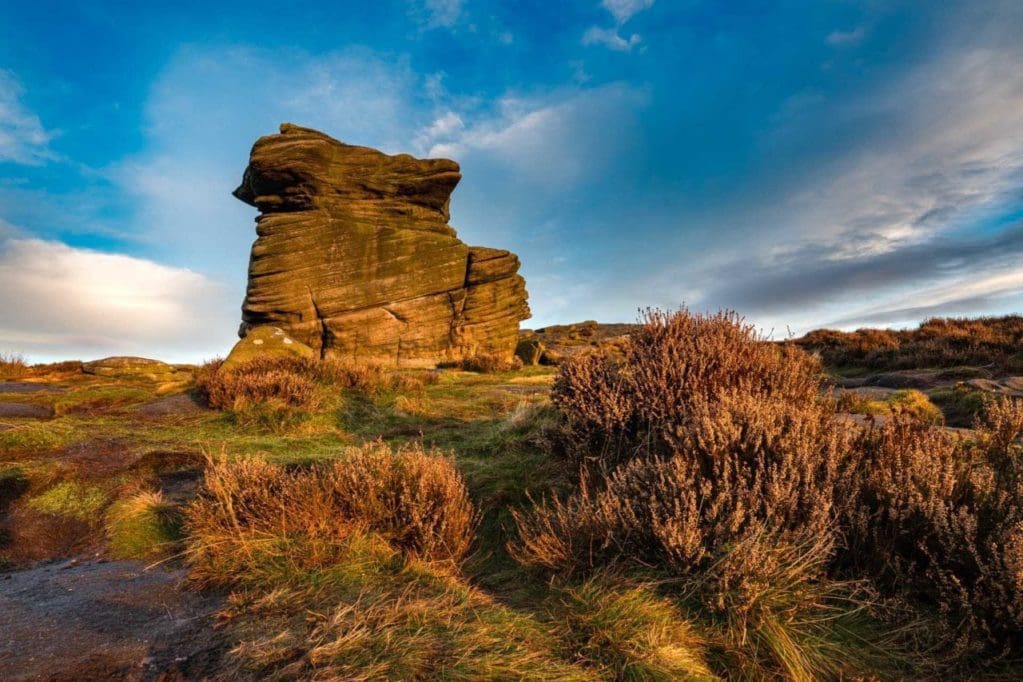
Fujifilm GFX 50S with GF23mm f/4 lens. Exposure ISO 100, f/22, 1/4 second. RAW adjustments in Lightroom CC Exposure +1, Highlights -100, Shadows +50, Whites +25, with a Graduated Filter to enhance the foreground. Fujifilm built-in lens profile and a Medium Contrast Tone Curve applied.
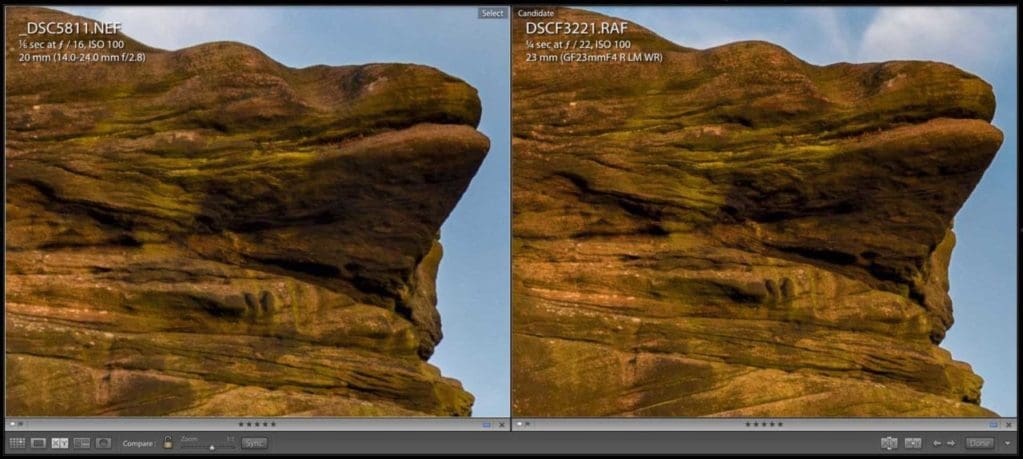
1:1 crops on-screen show the sharpness and contrast on the GFX (right) is fractionally better than the D850 (left) but there’s really not that much in it.
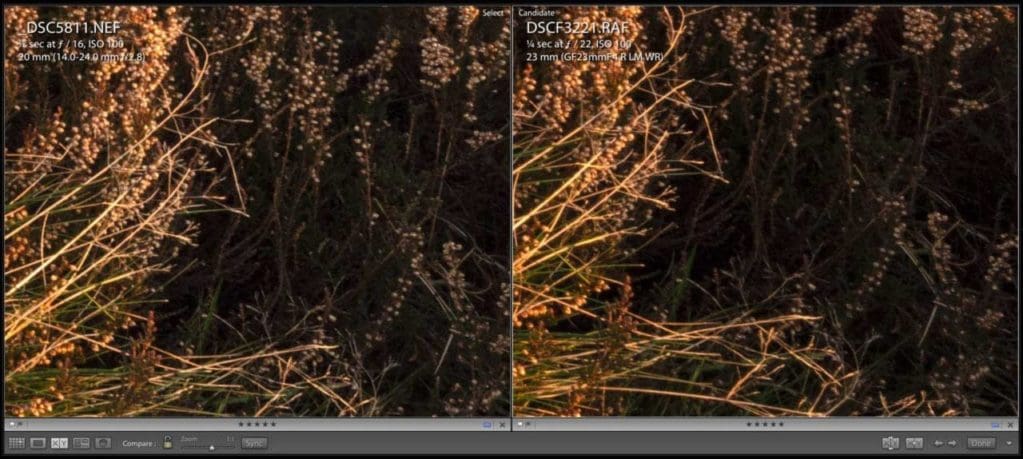
1:1 crops on-screen of shadow areas show noise is well-controlled on both files with modest raw adjustments.
For printing landscapes, I prefer the D850’s native 3:2 aspect ratio, compared to 4:3 on the GFX. If you crop the GFX files to 3:2, the resolution is exactly the same as the D850, so both produce a 30×20-inch print at 275ppi. If you print standard A paper sizes, however, there’s slightly less cropping involved with the GFX. So you get an A1 print at 249ppi on GFX, compared to 235ppi on the D850.
It’s not a significant difference, with both packing plenty of resolution for large scale prints, but depending where your images are destined for one of the aspect ratios might make more sense.
After a spot of breakfast and with the light still good, we headed off for a few additional shots. Shooting f/16 on both lenses, but this time using the GF 32-64mm f/4, we found a spot with plenty of blue and green tones to assess the colour.
WIth a Custom White Balance of 7000 Kelvin and +10 Tint set for both during raw conversion and again I’d say the GFX is marginally richer, warmer and more saturated, but there’s not much in it, and a few colour tweaks to the D850 file and the result could be the same.
Nikon D850
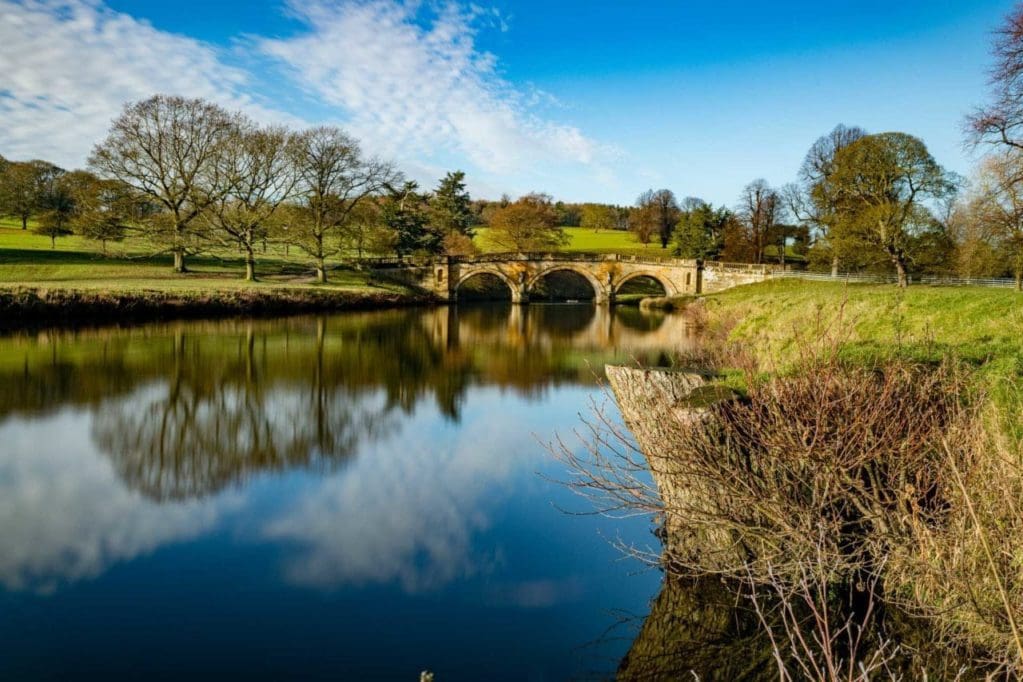
Nikon D850 with Sigma 35mm f/1.4 A lens. Exposure ISO 100, f/16, 20 seconds. RAW adjustments in Lightroom CC Exposure +0.7, Highlights -100, Shadows +100, Blacks -20 and Dehaze +50. Lens Profile enabled and a Medium Contrast Tone Curve applied.
FujiFilm GFX 50S

Fujifilm GFX 50S with GF 23-64mm f/4 lens. Exposure ISO 100, f/16, 20 seconds. Raw adjustments in Lightroom CC Exposure +1.2, Highlights -100, Shadows +100, Blacks -20 and Dehaze +50. Built-in lens Profile and a Medium Contrast Tone Curve applied.
This was the first shot where we noticed the GFX was considerably sharper. We were shooting the Sigma 35mm f/1.4 A at its minimum f/16 aperture, compared to f/16 being a mid-aperture on the GF lens, so diffraction will play a part, but still, the tree stump in the foreground is significantly sharper on the GFX file.
Depth-of-field is fractionally better on the Nikon file, with marginally better detail retention in the bridge in the background, but close down the GF lens to f/22 and it’d be the same and we’d be prepared to bet the GFX file is still sharper.

1:1 crops on-screen show a noticeable difference in sharpness shooting the D850 with Sigma 35mm prime at f/16 (left), compared to the GFX with GF 23-64mm at f/16 (right).
So, in summary from this landscape shoot, we concluded there isn’t a huge amount of difference in dynamic range when shooting at low ISOs in good light and although the GFX just edges it for colour saturation, it’s close.
Using minimum apertures on the GF lenses, sharpness is good, with decent depth-of-field, but open up the aperture a stop or two on the GFX lenses and sharpness is insane for those landscape shots you don’t need the maximum depth-of-field.
Low Light landscape
Next, we wanted to see how much of an advantage the GFX 50S’s greater pixel pitch was in low light shooting some urban landscape.
Shooting the council buildings and fairground rides with long exposures at night colour rendition is a little richer on the D850 file this time, with slightly warmer tones, but the GFX file is still nicely saturated. Again there’s a difference in sharpness, with the GFX image tack-sharp both in the railings around the carousel and the windows of the building in the background.
To be fair, the GFX image was shot at a mid f/11 aperture, compared to f/16 minimum aperture with the Sigma 35mm prime on the D850, which will have some impact, but the GFX is significantly sharper. We also had to push the D850 file a little harder to achieve a similar result as the GFX. Clearly, we should have shot the D850 image at f/11 too – but even so, there’s significantly more luminance noise visible in the D850 shot.
Nikon D850

Nikon D850 with Sigma 35mm f/1.4 A lens. Exposure ISO 100, f/16, 3 seconds. Raw adjustments in Lightroom CC Exposure +1.75, Highlights -50, Shadows +50, Blacks -25 and Dehaze +25. Lens Profile enabled and a Medium Contrast Tone Curve applied.
FujiFilm GFX 50S

Fujifilm GFX with 45mm f/2.8. Exposure ISO 100, f/11, 5 seconds. Raw adjustments in Lightroom CC Exposure +1, Highlights -50, Shadows +50, Blacks -25 and Dehaze +25. Lens Profile enabled and a Medium Contrast Tone Curve applied.
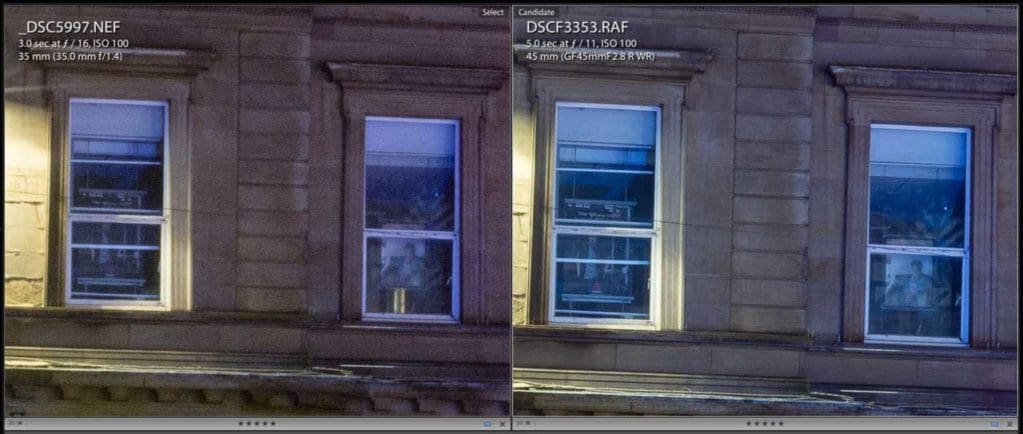
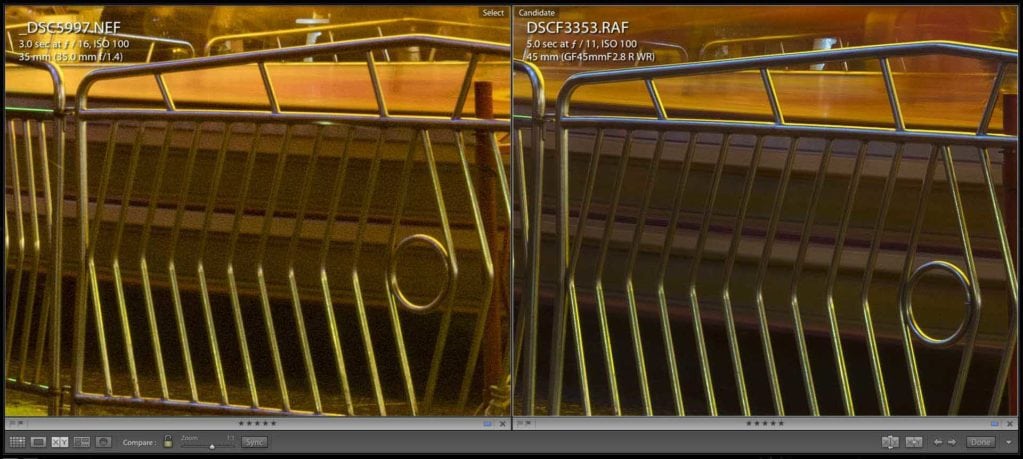
1:1 crops on-screen show a significantly less noise and greater sharpness in the GFX file (right), although we did have to push the D850 raw file (left) a little harder.
The same analysis bears out on the next shot of the ice rink and Christmas tree, with noticeably less noise and greater sharpness on the GFX file. Although the JPEG preview reviewed on the LCD screen indicated a good exposure at ISO64, f/11, 2 seconds on the D850, it looked very dark on the GFX using the Classic Chrome film pre-set and the resulting raw files were underexposed for both cameras.
We did get better results ‘in-camera’, shooting longer exposure times and wider apertures on both cameras, but it’s interesting to see how these initial shots held up with some aggressive raw processing. Pushing Exposure +2.5 and Shadows +50 to isolate the top of the Council House from the dark sky significantly amplifies the noise on the D850 file, with a chromatic element starting to become visible. In comparison, the GFX file remains relatively smooth, which shows the advantage the GFX’s larger pixel pitch offers in low light.
Colour is a bit richer and more saturated on the D850 file, especially in the sky which retains more blue tones. The GFX shot is noticeably sharper again though, and ‘pixel-peeping’ the top of the Council House, the GFX displays incredible clarity and detail.
Nikon D850
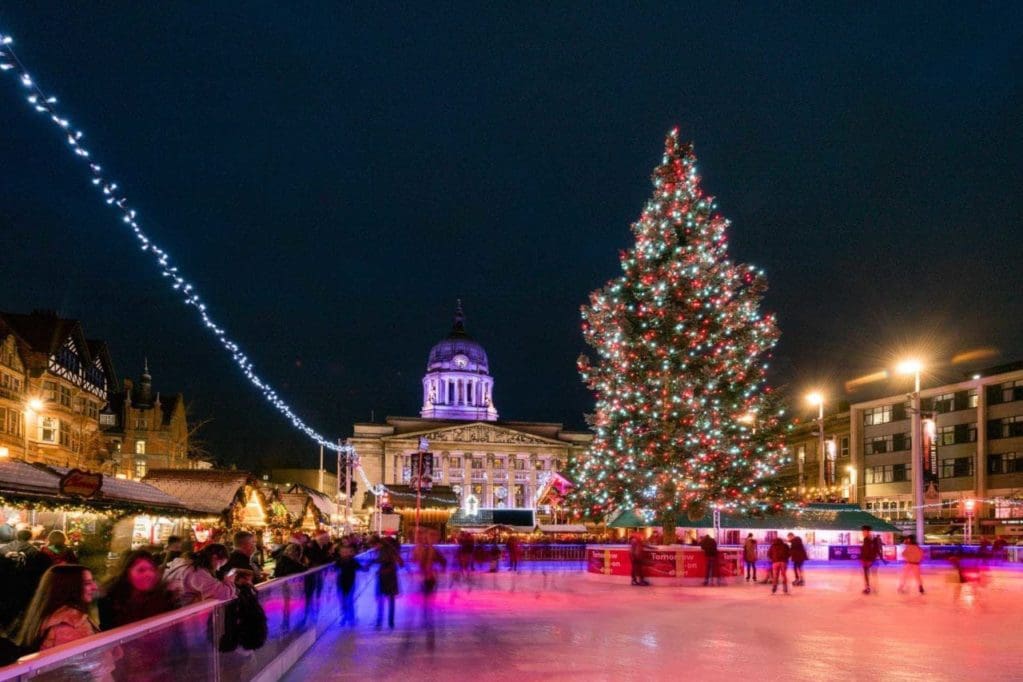
Nikon D850 with Nikkor 14-24mm f/2.8 lens. Exposure ISO 64, f/11, 2 seconds. Raw adjustments in Lightroom CC Exposure +2.5, Highlights -50, Shadows +50. Lens Profile enabled and a Medium Contrast Tone Curve applied.
Fujifilm GFX 50S
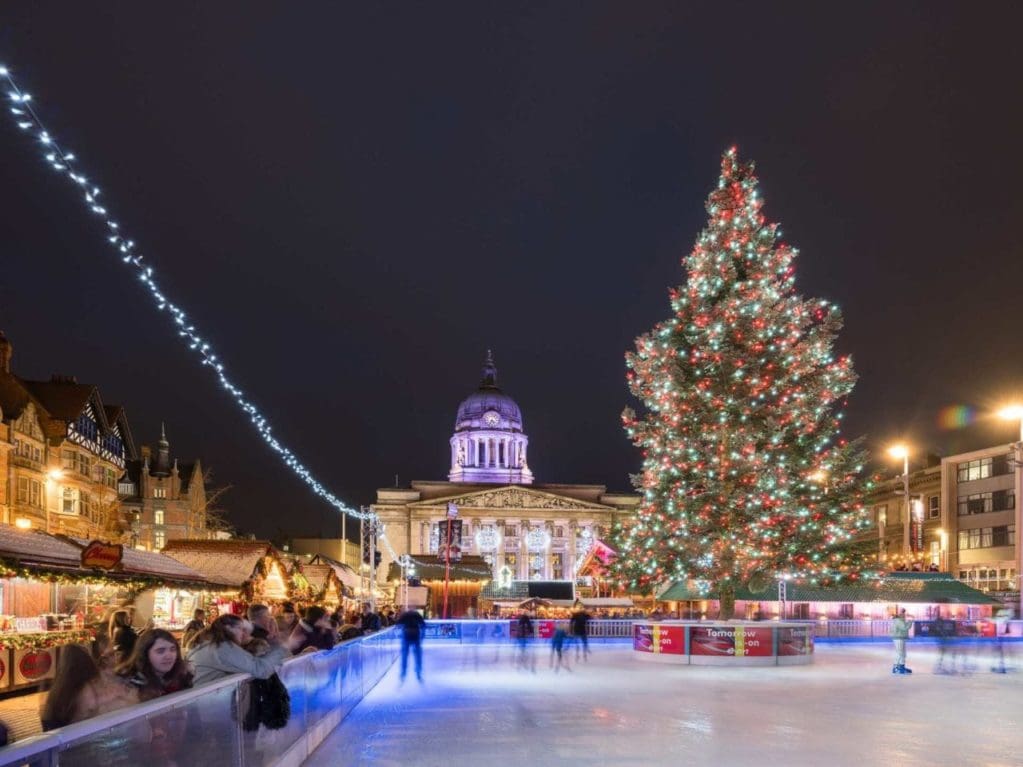
GFX 50S with GF 23mm f/4 lens. Exposure ISO 100, f/11, 2 seconds. RAW adjustments in Lightroom CC Exposure +2.5, Highlights -50, Shadows +50. Lens Profile built-in and a Medium Contrast Tone Curve applied.
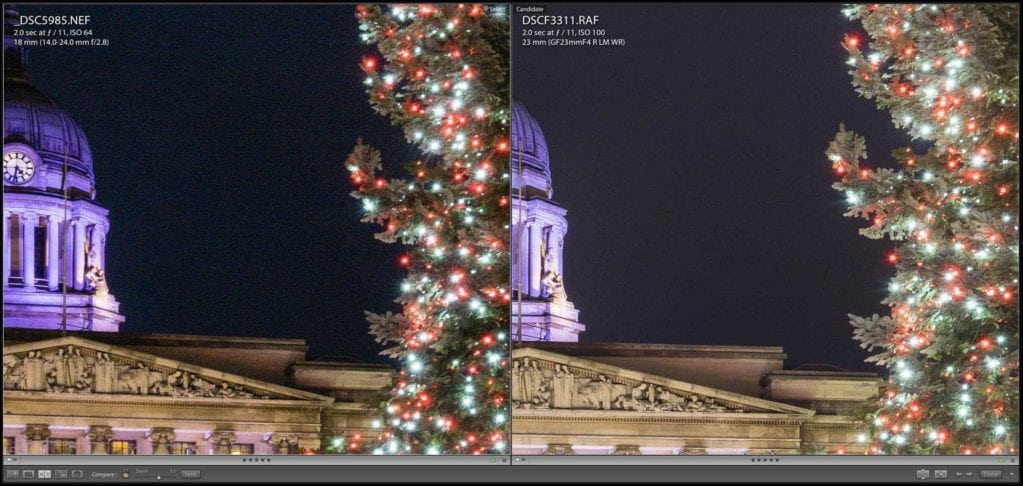
1:1 crops on-screen shows some chromatic noise on the D850 file (left) when pushing the exposure and shadows hard in raw processing. The GFX file holds up better, with notably improved sharpness and detail.
Comparing the ‘as shot’ jpegs of the same image, the D850’s in-camera processing has done a better job of lighting the exposure and removing the noise, compared to our Lightroom raw conversion. The GFX file remains a little smoother, but results are much closer.
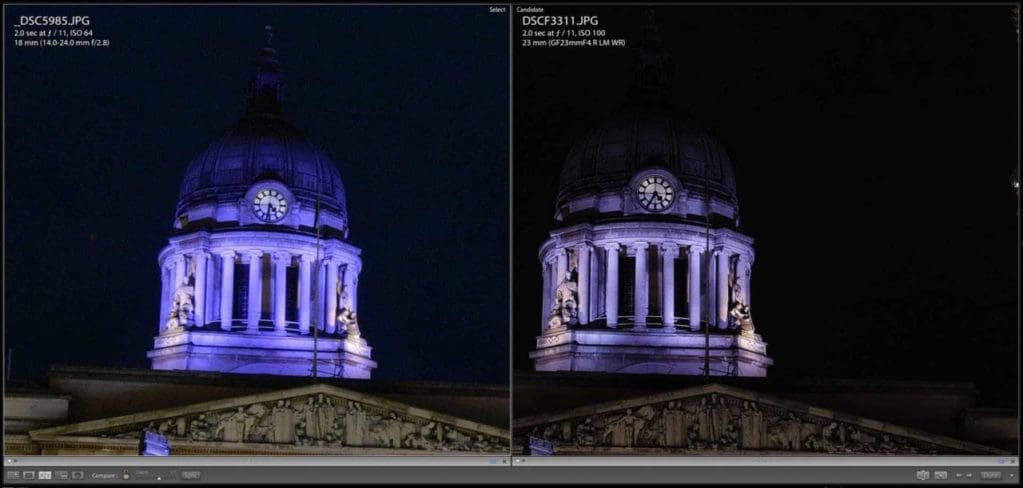
The D850 in-camera JPEG processing has lightened the exposure and removed most of the noise, but the GFX file remains a little cleaner and significantly sharper, but it’s a stop underexposed.
Slightly intrigued by this difference in exposure and JPEG processing, we headed off to the market stalls to shoot a bit of street and reportage style photography.
Switching to Av mode, shooting the same ISO 1600 and f/2.8 settings and framing up as consistently as we could in a dynamic environment, the D850 appeared to be more sensitive to light, by around 2 stops, giving us significantly faster shutter speeds. With its greater pixel pitch you’d expect the GFX’s sensor to be more light sensitive, but with different light transmission of the lenses that produce different sized image circles, as well as the different physical sensor sizes, it’s difficult to pin down exactly what’s going on.
There was a big difference in the shutter speeds though, with the Nikon D850 at 1/800th sec compared to 1/220th on the GFX.
Nikon D850

Nikon D850 with Sigma 35mm f/1.4 A lens. Exposure ISO 1600, f/2.8, 1/800 sec in Av mode.
Fujifilm GFX50S

Fujifilm GFX 50S with GF 45mm f/2.8 lens. Exposure ISO 1600, f/2.8, 1/220 sec in Av mode.
The overall exposure of the two shots is pretty similar, with no significantly blown highlights. Close inspection of the shadow areas, however, shows the GFX file has less noise, better texture retention, as well as less blocking in the shadows with more detail visible.
In the brighter sections of the counter, the difference in noise is less significant, but the GFX file remains a little sharper. We could have shot the D850 at ISO400 to get a comparable 1/200th-second shutter speed, which would have helped improve the noise in the shadows.
Using the Standard Picture Control on the D850 and Astia film simulation mode on the GFX the colour is a little richer, warmer and more saturated on the D850 shot, but which you prefer comes down to personal preference and one of the alternative film simulation modes on the GFX such as Velvia would have produced richer colour.
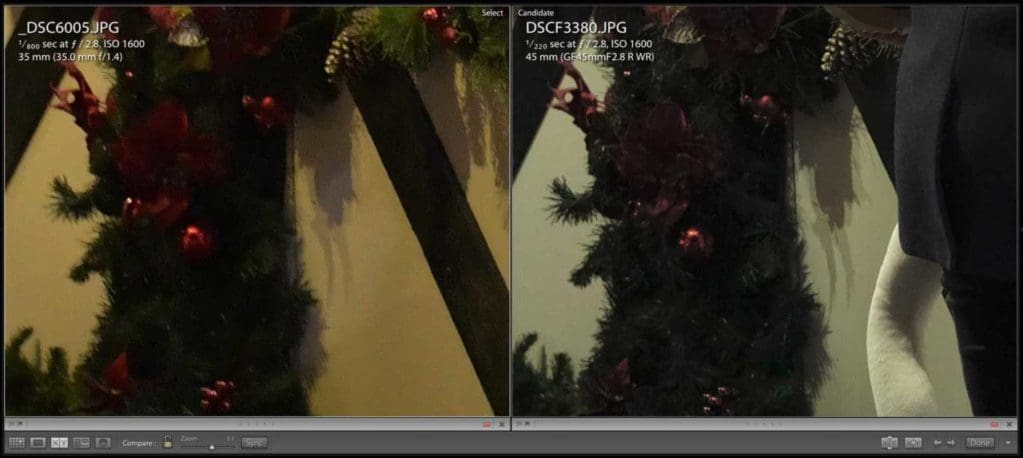
1:1 crops on-screen shows less detail retention and a little more noise in the shadow areas on the D850 file (left)compared to the GFX (right) on in-camera process JPEGs shooting in Av mode.

In brighter sections levels of noise are more comparable between the two, but again the GFX file is a little sharper.
Portraits
With some landscapes and low light shots in the metaphorical ‘can’, we turned our attention to portraiture. First up, we shot some headshots with nothing but natural light and a reflector, using the maximum aperture on the Nikon 105mm f/1.4 and the GF 110mm f/2 (85mm equivalent).
With both lenses close to their respective minimum focus distances, you can see the depth-of-field is broadly the same, with sharp focus only extending a few millimetres behind the focus point. So actually the GFX’s larger medium format sensor is capable of a more pronounced shallow depth-of-field effect, as we were able to achieve the same background blur at f/2, compared to f/1.4 on the D850.
The GFX file is noticeably sharper on the eyes, with clearly defined individual eyelashes that are razor sharp. Focus is fractionally off on the D850, which isn’t hard to do when you’re shooting f/1.4 at such close distances. The GFX’s contrast detection autofocus system is pretty useful here, as you can set the size of the focus point and position anywhere in the frame, enabling easy composition and perfect focusing for portraits.
Whilst the D850 has a total of 153 autofocus – so loads! – only 55 of them are selectable (yeah, only 55!), so if there isn’t one that’s perfectly aligned with an eye on your portrait composition you’re going to have to ‘focus lock and recompose’ (or focus manually). It doesn’t take much camera movement to throw the focus a little.
Another advantage the GFX offers for portraiture is the image playback in the EVF after capture. While we find this feature a little irritating in fast-paced environments (it can of course) be disabled, but it’s especially useful for portraits to see if your subject has nailed the expression.
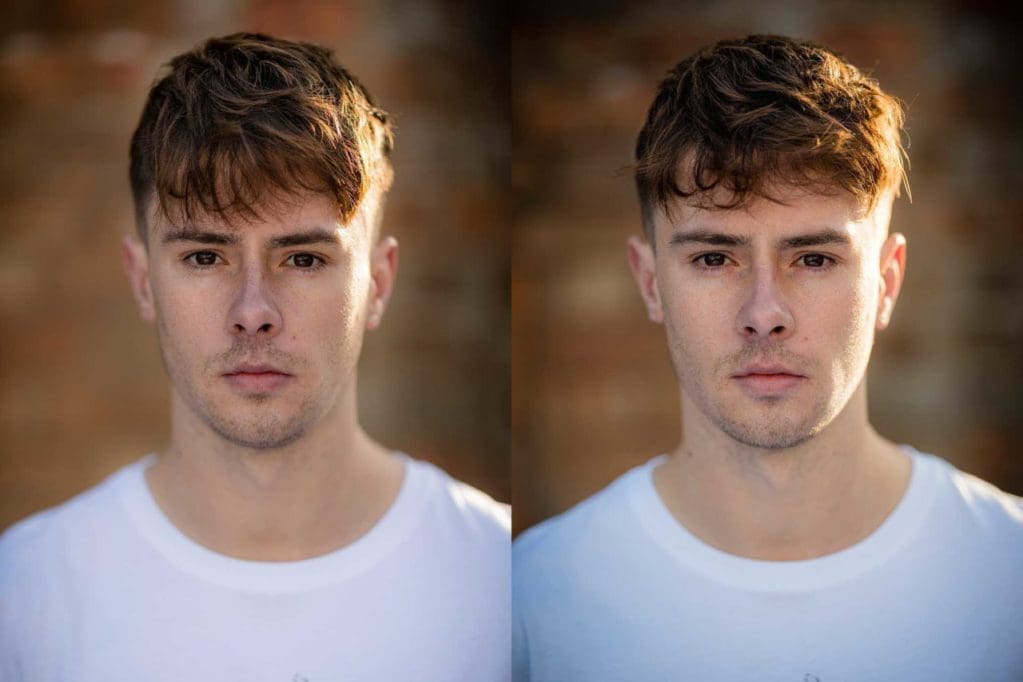
Using the respective f/1.4 and f/2 maximum apertures on the D850 with 105mm lens (left) and GFX with 110mm f/2 lens (right) depth-of-field is broadly the same.

Close inspection of 1:1 crops on-screen shows outlandish sharpness on the eye, with the Nikon D850 perhaps fractionally missing focus, which is easy to do at such close focusing distance with the maximum aperture.
Next up, we set up some Godox flash heads to see how both cameras faired shooting TTL high-speed sync. Using their respective maximum apertures for background blur, a fast shutter speed to accurately expose the highlights in the background, and positioning the subject in the shadows, the flash worked flawlessly on both cameras, accurately exposing the model.
The depth-of-field effect produced by the short telephoto focal lengths is again broadly similar, despite the GFX lens using a narrower f/2 aperture, and the result is very pleasing on both. Skin tones are slightly pinker and more accurate on the GFX file, with good saturation in the background, but overall the colour rendition is pleasant on both shots.
Nikon D850

Nikon D850 with Nikkor 105mm f/1.4 lens. Exposure ISO 31, f/1.4, 1/2000 seconds. Raw adjustments in Lightroom CC WB Flash pre-set, Highlights -25, Shadows +25, Clarity -20. Lens Profile enabled and a Medium Contrast Tone Curve applied.
FujiFilm GFX 50S

Fujifilm GFX 50S with GF 110mm f/2 lens. Exposure ISO 100, f/2, 1/2000 seconds. Raw adjustments in Lightroom CC WB Flash pre-set, Exposure +0.3, Highlights -50, Shadows +50, Clarity -20. Lens Profile built-in and a Medium Contrast Tone Curve applied.
Viewing images at 1:1 on-screen, the GFX is again noticeably sharper.
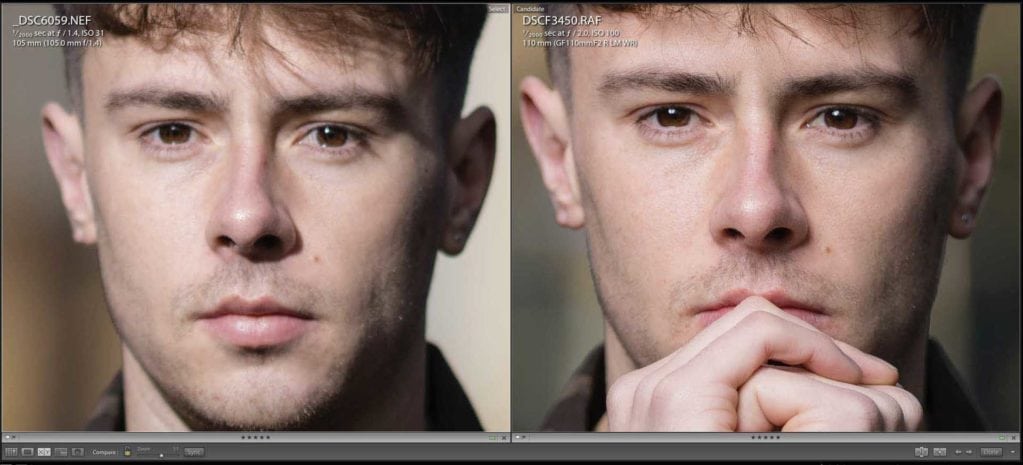
1:1 crops on-screen show the GFX file (right) is a little sharper than the D850 (left).
Finally, we headed into the studio to shoot some portraits using conventional flash.
Flash sync speed on the GFX is limited to 1/125th of a second and whilst it’s possible to get a leaf-shutter lens adapter enabling faster shutter speeds with conventional flash, it increases the ‘faff’ and expense.
With the D850 you can get away 1/250th with many flash heads, although 1/200th is often a little safer. That faster shutter speed will potentially give you a sharper portrait, if you’re mixing flash with ambient light. If you’re planning on getting the GFX principally for portraiture, a high-speed sync flash set up is definitely recommended, even just to enable a 1/250th shutter.
With lots of ambient light in the natural light studio we were using, we shot a 1/125th shutter on both cameras to match the exposure. The GFX file is again slightly sharper overall, but a little motion blur is evident on both shots.
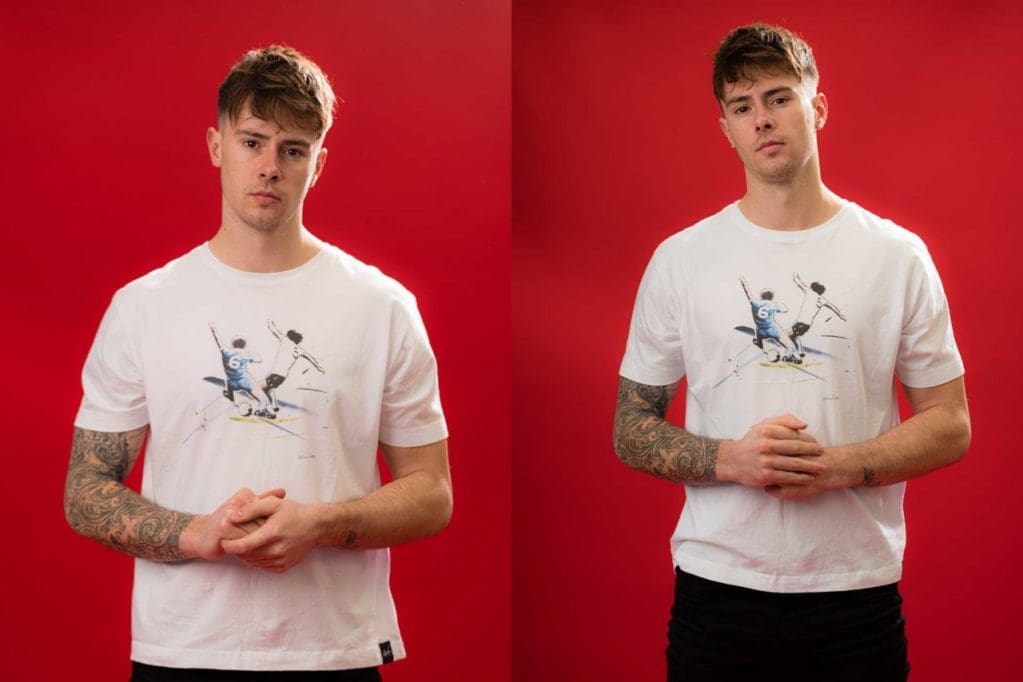
Studio portraits were shot at f/2.8 1/125th second, which is the faster flash sync speed for using conventional flash on the GFX (right), but it’s possible to go as fast as 1/250th second on the D850 (left).
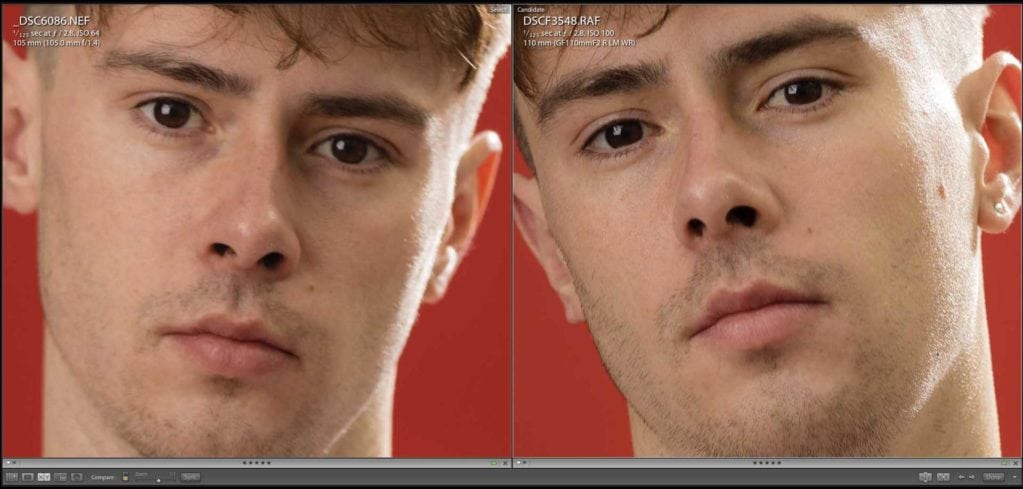
Examining 1:1 crops on screen the GFX file (right) is again a little sharper.
Prints

We made a bunch of A3+ prints using the relatively budget-level 5-head Canon iX6550 inkjet on Ilford Galerie 310gsm Smooth Pearl paper. The D850 producing full bleed prints at 434ppi, compared to 478ppi for the GFX files.
All our prints looked amazing in isolation and although superior print quality is no doubt possible on 10-head professional printers, and a 16-bit colour workflow, the tones and colour graduations were very good from both cameras in our prints.
We conducted a blind test with the designers and art directors at the creative agency Stencil. In all but one case they preferred the GFX prints, but they couldn’t pick a winner between the two sunrise landscape images. The comments were that the prints from both cameras were exceptional, with great colour and tonality, and although they thought there was very little between them, the GFX prints offered slightly improved clarity and sharpness.
If you’re looking to print bigger than A3+ that extra definition will no doubt be amplified on the GFX prints. As we’ll be getting some massive A0 prints done for the studio in the future, we’ll no doubt get the GFX files printed.
Conclusion
The image quality potential of both these cameras is incredible. The GFX 50S’s physically larger medium format sensor and consequent larger GF lenses (which were designed to resolve for 100Mp sensors, which you would assume are coming in due course) gives the Fujifilm camera an advantage for sharpness. It’s the standout difference between the two cameras, and whilst the D850 is far from bad, if you’re ‘pixel-peeping’, detail resolution can be outrageously good from the GFX. This translated into sharper A3+ prints from the GFX, which were generally preferred by the art directors in our blind test, although they kept reiterating there was very little in it.
In low light, there’s less noise in the images from the GFX and we found the Fujifilm raw files held up better during conversion if you need to aggressively push the exposure. Landscapes shot in good light dynamic range were similar, with image quality holding up well on both cameras when under-exposing for the highlights and lifting the shadows in post. Colour is also excellent and comparable between the two, with the colour we preferred varying in the different images.
So, is image quality on the Nikon D850 as good as the Fujifilm GFX 50S? On balance, not quite, but it’s not far off.
If you’re shooting in relatively slow-paced environments, capturing portraits, product, landscape, advertising or editorial images you’d opt for the GFX if your budget allows. It’s a slightly chunkier beast compared to the semi-pro body D850, but handling is comfortable and intuitive (especially if you’re used to Fujifilm X-Series hybrids) and dials can be customised to your preferred set up. The GFX doesn’t offer the speed and performance of the D850, so if you’re looking for fast autofocus and burst shooting, combined with super high resolution, the Nikon D850 is a dream. For wildlife and wedding photography particularly that balance between performance and image quality is interesting. The autofocus speed and frame rate to keep pace with the wildlife and -4Ev for low light autofocus at weddings, combined with super high-resolution files for cropping in tight or high-quality prints and albums, makes the Nikon D850 ideal for these subjects.
Follow the link to browse the full-resolution images
[FAG id=58923]
